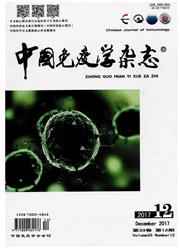

 中文摘要:
中文摘要:
目的 探讨马传染性贫血病毒(EIAV)驴白细胞减毒疫苗(DLV)免疫马后,外周血单个核细胞(PBMC)中自细胞介素12(IL-12) mRNA转录水平与免疫保护应答的关系,揭示DLV的免疫保护机制。方法应用分子克隆及实时定量反转录一聚合酶链反应(RT-PCR)技术,建立马PBMC中IL-12 mRNA转录水平的定量检测方法,在不同时间点定期观察4组(疫苗免疫组、阴性对照组、强毒株阳性对照组和EIAV自然感染组)12匹马PBMC中IL-12mRNA转录水平及分布特征,同时监测体温变化等指标。疫苗株免疫动物8个月后,用EIAV强毒株攻击,观察攻击前、后IL-12mRNA转录水平的变化。结果DLV免疫马在免疫期内,PBMC中IL-12mRNA转录的量略高于阴性对照组及自然感染组,但免疫后8个月用EIAV强毒株攻击,IL-12mRNA转录量显著升高,4匹免疫马获得完全保护;强毒株阳性对照组IL-12转录量随疾病进展波动,发热期下降。结论本研究首次证明EIAV减毒疫苗可诱导马外周血PBMC中IL-12基因高效转录,其转录水平与DLV的免疫保护密切相关。此结果在分子水平为阐明DLV的免疫保护机制提供了新的实验依据。
 英文摘要:
英文摘要:
Objective To elucidate the mechanism of immune protection for a donkey leukocyte attenuated vaccine (DLV) against Equine Infectious Anemia Virus (EIAV) by examining the relationship between immune protection and the levels of IL-12 mRNA transcription in peripheral blood mononuclear cells (PBMC) from immunized horses.Methods A real-time PCR method was established to detect the levels of IL-12 mRNA transcription in horse PBMC.Twelve horses were divided into four groups: vaccination group, healthy negative control group, positive control group with viral challenge and EIAV natural infection group. The levels and distribution of IL-12 mRNA transcription in PBMCs were analyzed. The body temperature of the inoculated horses was monitored on a daily basis. Horses inoculated with DLV vaccine were challenged 8 months post-inoculation, and the level of IL-12 mRNA transcription in PBMCs was evaluated pre- and post-challenge. Results The level of IL-12 mRNA transcription in vaccinated group was only slightly higher than in the healthy control and naturally infected groups. It became significantly higher after being challenged with virulent EIAV strain and four vaccinated horses were completely protected. In this challenged group, the level of IL-12 mRNA fluctuated as the disease progressed, and descended during the febrile episodes. Conclusion This study for the first time revealed that attenuated EIAV vaccine could induce high level transcription of IL-12 mRNA, which was correlated closely with immune protective response induced by DLV. This finding provided new information regarding to the mechanism of immune protection for DLV at the molecular level.
 同期刊论文项目
同期刊论文项目
 同项目期刊论文
同项目期刊论文
 期刊信息
期刊信息
